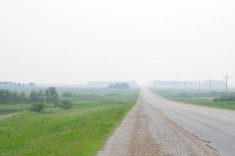One highly touted benefit of riparian areas may not be entirely accurate in a prairie context.
Research conducted in southern Manitoba shows that riparian areas in the Canadian Prairies are not as effective at filtering nutrients in runoff from agricultural lands as in other regions.
“Over the past couple decades, much attention has been given to the potential of riparian areas to filter nutrients in agriculture runoff and reduce the load of nutrients being carried downstream to sensitive water bodies,” said Dr. David Lobb, professor of soil science at the University of Manitoba and senior research chair for the Watershed Systems Research Program.
Read Also

Pen riders still better than tech at detecting respiratory disease in feedlot cattle, says researcher
Recent research found that pen riders are better than tech at flagging signs of BRD in feedlot cattle
“There’s a great public and political desire to reduce nutrients from agricultural lands, particularly the runoff from phosphorus, to improve the state of our surface waters, and riparian areas are seen as a fantastic solution,” he said in a presentation at Ag in Motion Discovery Plus.
“However, these initiatives have not given serious consideration to whether or not these areas actually filter nutrients.”
While most of the research supporting this claim was conducted in more southerly climates with longer growing seasons, there have been few studies on the ability to filter nutrients in a prairie setting. One of the few conducted in the Canadian Prairies is a series of studies by the University of Manitoba, the University of Northern British Columbia and other collaborators, done over a 15-year span in southern Manitoba.
Several locations were analyzed along the Whitemouth River and the South Tobacco Creek watershed, within the East Interlake Conservation District, Little Saskatchewan Conservation District and the Pembina Valley Conservation District and at the Agriculture and Agri-Food Canada Research Station at Morden, Man. Researchers placed weirs at each site to collect runoff at the edge of fields and within riparian areas. Runoff water was assessed for phosphorus, nitrogen and sediment.
Lobb reported that in three of these studies, there were not significant decreases in phosphorus and nitrogen after runoff ran through riparian areas. While some of the sites had small reductions, others saw an increase in nutrients after flowing through these areas.
“We found that riparian areas can be a source of dissolved nutrients as well as a trap or a sink for those nutrients. In other studies we have carried out, we found that any vegetation on the soil surface anywhere in the watershed can be a source of dissolved nutrients.”
One reason for prairie riparian zones not being as effective filters as those found elsewhere is the cold climate of this region. “About 80 to 85 per cent of the runoff of water and nutrients occurs during snowmelt, when the ground is impermeable and the vegetation is not capable of consuming water and nutrients,” said Lobb.
These areas could, in theory, filter around 15 to 20 per cent of nutrients and sediment in runoff from rainfall during the growing season, which is still significant.
“But in our landscapes, water runs off a field in a concentrated flow along surface drainage paths, and this flow passes right through the riparian area in a very limited zone that allows for very little if any infiltration and uptake of those nutrients.”
Even if the vegetation could take up large amounts of nutrients, it should ideally then be removed before acting as a nutrient sink for surface waters.
These studies suggest there are options for improving filtration ability, but the challenge is to maintain the natural state of riparian zones.
“To reduce nutrient delivery to surface waters, we must manage soils and crops to reduce the runoff and nutrients leaving the agricultural land and entering riparian areas,” said Lobb.
One management option is to use in-field surface drainage ditches and harvest the vegetation to reduce nutrients.
“On the Red River plain, each section of land has about 20 to 25 kilometres of in-field surface drains per section, with 40 to 60 surface drains to four to six kilometres of drainage ditches around those sections,” he said.
“Beyond the field, the vegetation of these riparian areas is not managed for the purposes of nutrient filtering or removal, but if it was it is possible to achieve considerable reductions of nutrients to surface waters.”

















